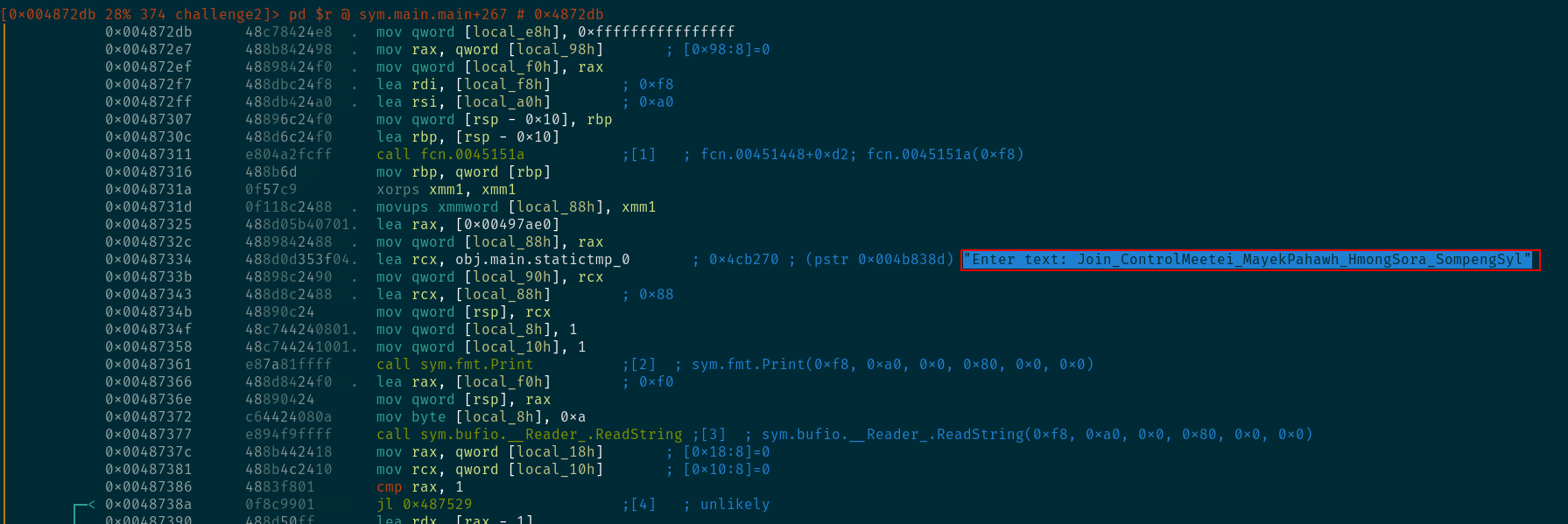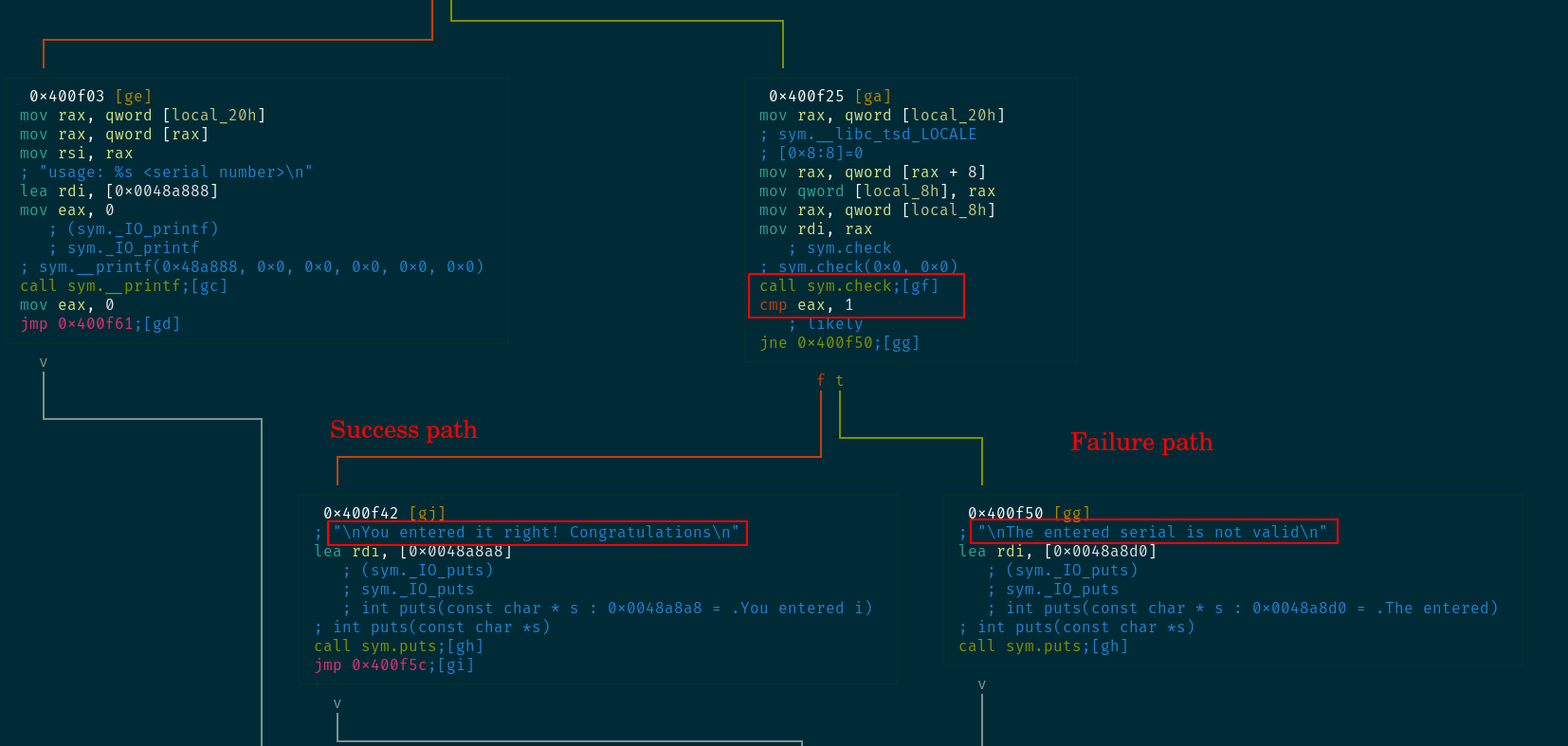
This CTF took place in Berlin’s N26 office. It was hosted by nobe4 and the CTF was made by mehdideveloper
Open-up Wireshark. Right-click any packet and choose "Follow TCP Stream". You'll find the flag sent over many packets.
Flag is: FLAG:385b87afc8671dee07550290d16a8071
[0] % file challenge2
challenge2: ELF 64-bit LSB executable, x86-64, version 1 (SYSV), statically linked, Go BuildID=6Rdi132Q4CaVhigo8VXg/IZu9ZeSNp3culgg8mH9n/cSgSNHoa4WWrvKF2fivx/JC1b1rnuLRoE5aM2_NgB, not stripped
[0] % rabin2 -I challenge2
Warning: Cannot initialize dynamic strings
arch x86
baddr 0x400000
binsz 1938452
bintype elf
bits 64
canary false
sanitiz false
class ELF64
crypto false
endian little
havecode true
lang go
linenum true
lsyms true
machine AMD x86-64 architecture
maxopsz 16
minopsz 1
nx true
os linux
pcalign 0
pic false
relocs true
rpath NONE
static true
stripped false
subsys linux
va trueWe see it's a unstripped ELF binary compiled with Go. I also see that it's statically-linked so decompilation will not be easy through any framework.
Running it we see:
cheese@291233 : ~/dev/ctf/sectalks0x03
[0] % ./challenge2
Enter text: AAAAA
Wrong flagThe flag is supplied through a command line argument. Since it's compiled with Go, I'd rather take a quick look through static analysis before jumping with a debugger, since I don't think it'll be easy to attach GDB to this and understand what's happening. I do know that Radare2 has some support for Go binary decompilation.
We saw that the the binary is statically-linked, Luckily enough, the binary is simple so running through the main function and grepping for strings should be sufficient to know where we are.
[0] % r2 challenge2
r_config_set: variable 'src.color' not found
Warning: Cannot initialize dynamic strings
-- In Soviet Russia, radare2 has documentation.
[0x00451ec0]> aa
[Usage: afn newname [off] # set new name to given function
WARNING: r_bin_get_vaddr: assertion 'bin && paddr != UT64_MAX' failed (line 1383)
[x] Analyze all flags starting with sym. and entry0 (aa)
[0x00451ec0]> afl~main
0x00428560 33 852 sym.runtime.main
0x0044d7e0 3 71 sym.runtime.main.func1
0x0044d830 5 60 sym.runtime.main.func2
0x004871d0 15 884 sym.main.main
0x00487550 7 112 sym.main.init
[0x00451ec0]> We see that r2 identified a main function. It didn't take too long to decompile. I don't wanna dive too deep into the binary since it's statically-linked.

We see that the name of the functions is sane: sym.runtime.makeslice. In Go, Slices are a thing.

scrolling down a bit more shows that r2 was able to identify the initial "Enter text: " string. I do see that it is concatenated with some more weird strings. If you actually go and see the strings in the data section, you'll find that Go binaries concatenate all strings together, so this is normal.

After entering Visual Graph mode, as shown in the image above, we see that a there is a branch into either "Good job" or "Wrong flag". Right above it we see a call to sym.runtime.memequal, which I'm assuming is meant to compare memory regions.
So, I'm assuming that "U2VjVGFsa3NGbGFn..." is the flag. I don't know where exactly does it end, since the strings here are concatenated, but since it looks like base64, I can just run it and see what sticks.
[0] % echo "U2VjVGFsa3NGbGFnZanabazar_Square" | base64 -d
SecTalksFlagembase64: invalid inputSo, "Zanabazar_Square" is not in the string,
[0] % echo "U2VjVGFsa3NGbGFn" | base64 -d
SecTalksFlag% A smarter way would be to go back and see the length of the variable holding the actual string (local_8h), but this works just as well.
So the flag is SecTalksFlag
[0] % unzip challenge3.zip -d challenge3/
Archive: challenge3.zip
extracting: challenge3/enc.message
inflating: challenge3/pub.key
[0] % cat challenge3/enc.message
v7NInixO/Va1|SaG$;R(V{"3FΙYK MW
[0] % cat challenge3/pub.key
-----BEGIN PUBLIC KEY-----
MIGfMA0GCSqGSIb3DQEBAQUAA4GNADCBiQKBgQDolThJ8R6TLpEnrzXhAAAAAAAA
AAAAAAAAAAAAAAAAAAAAAAAAAAAAAAAAAAAAAAAAAAAAAAAAAAAAAAAAAABR+Ot9
BVbgn///////////////////////////////////////////////////////////
//////////////utVQIDAQAB
-----END PUBLIC KEY-----So we have here a poorly-generated keypair and a message encrypted with it. We can either find a way to break the cryptographic algorithm or derive the private key from the poorly-generated public key. The latter sounds like a better option.
For this challenge, I cheated and used RsaCtfTool. An analyst should understand what's happening, but my knowledge of crypto and RSA is delegated to people who know more.
Using RsaCtfTool to derive the private key is pretty easy:
[0] % python RsaCtfTool.py --publickey challenge3/pub.key --private > challenge3/private.key
[0] % openssl rsautl -decrypt -in challenge3/enc.message -inkey challenge3/private.key
V293LiBZb3UgZm91bmQgdGhlIGZsYWchIFdlbGNvbWUgdG8gdGhlIHdvcmxkIG9mIENURgo=
[0] % openssl rsautl -decrypt -in challenge3/enc.message -inkey challenge3/private.key | base64 -d
Wow. You found the flag! Welcome to the world of CTFQuick explanation to the above: we ran RsaCtfTool.py with the supplied public key and the --private switch to have it generate the private key for us in challenge3/private.key.
Afterwards, we used openssl rsautil -drcrypt to decrypt enc.message with our newly-generated private key.
The generated message looks like base64, so we ran it with base64 -d and bingo the flag is Wow. You found the flag! Welcome to the world of CTF
[0] % file challenge4
challenge4: ELF 64-bit LSB executable, x86-64, version 1 (GNU/Linux), statically linked, for GNU/Linux 3.2.0, BuildID[sha1]=2b106a06881d4b74d679e214a5300eb43013efe1, not stripped
[0] % rabin2 -I challenge4
Warning: Cannot initialize dynamic strings
arch x86
baddr 0x400000
binsz 806339
bintype elf
bits 64
canary true
sanitiz false
class ELF64
crypto false
endian little
havecode true
lang c
linenum true
lsyms true
machine AMD x86-64 architecture
maxopsz 16
minopsz 1
nx true
os linux
pcalign 0
pic false
relocs true
rpath NONE
static true
stripped false
subsys linux
va true
[0] % ./challenge4
usage: ./challenge4 <serial number>
[0] % ./challenge4 123456789
The entered serial is not validAn unstripped, statically-linked ELF binary written in C. By running it, we see it's asking for a command line argument. My first assumption is the same as challenge2, which is that statically-linked binaries will cause more headaches than necessary, but since the binary is not stripped, I can just go in with Radare and check to see what is the main function doing.
[0] % r2 challenge4
r_config_set: variable 'src.color' not found
Warning: Cannot initialize dynamic strings
-- Don't wait for Travis
[0x00400a00]> aa
[Usage: afn newname [off] # set new name to given function
[anal.jmptbl] Missing cjmp bb in predecessor at 0x00441308
[anal.jmptbl] Missing cjmp bb in predecessor at 0x00441288
[anal.jmptbl] Missing cjmp bb in predecessor at 0x00479fcd
[anal.jmptbl] Missing cjmp bb in predecessor at 0x0047a03f
[x] Analyze all flags starting with sym. and entry0 (aa)
[0x00400a00]> afl~main
0x00400eee 7 117 main
0x004010b0 118 1683 sym.__libc_start_main
0x00416300 1 43 sym._IO_switch_to_main_get_area
0x00469130 1 49 sym._IO_switch_to_main_wget_area
0x00488050 7 73 -> 69 sym._nl_finddomain_subfreeres
0x004880a0 15 215 -> 203 sym._nl_unload_domain
[0x00400a00]> s main
[0x00400eee]> pds
Free fake stack
0x00400ef6 argc
0x00400ef9 argv
0x00400f0d "usage: %s <serial number>\n"
0x00400f19 call sym.__printf
0x00400f29 sym.__libc_tsd_LOCALE
0x00400f38 call sym.check
0x00400f42 "\nYou entered it right! Congratulations\n"
0x00400f49 call sym.puts
0x0048a8a8 sym._IO_puts)
0x00400f50 "\nThe entered serial is not valid\n"
0x00400f57 call sym.puts
0x0048a8d0 sym._IO_puts)
0x00400f76 arg3
0x00400f79 arg4
0x00400f83 arg3
0x00400f94 arg4
[0x00400eee]>Let's breakdown what happened: - Run the binary with r2 - Run aa to identify functions and basic flags - afl~main is just used to identify how did r2 map out the main function - s main is used to 'S'eek to main function - pds prints a disassembly summary
We see from pds that the called functions are just puts, and sym.check.

Binary is not too complex. The first command line argument is fed into this sym.check function which returns either a 1 for success or anything else for failure.
Taking a look at sym.check with Visual Graph mode is not pleasant...

So, making this function pass is pretty easy with a binary patch or an instrumentation framework. Unfortunately, it looks like the flag is the command line argument, so we'll have to find a way to extract it. I would go with symbolic execution [1] and Angr [2] at this point.

Let's give a simple summary of symbolic execution:
Wikipedia [3]:
In computer science, symbolic execution (also symbolic evaluation) is a means of analyzing a program to determine what inputs cause each part of a program to executeSo basically, we'll need to assign a specific condition or location where the binary takes the "Good Path". For us, If the binary reaches address 0x00400f42, we've successfully inputted a correct flag. This is the condition we would specify. The symbolic execution framework (Angr, in our case) will need to "explore" the binary and figure out which situation (commandline argument, in our case) would satisfy the necessary requirements to reach memory address 0x00400f42.
Here's how our python script would look like:
import angr
import claripy
import sys
def main(argv):
p = angr.Project('./challenge4', load_options={"auto_load_libs": False})
# Create a symbolic bitvector (the datatype Angr uses to inject symbolic
# values into the binary.) The first parameter is just a name Angr uses
# to reference it. The second is the length in bits
argv1 = claripy.BVS("argv1", 60*8)
initial_state = p.factory.entry_state(args=['./challenge4', argv1])
# Since our binary is statically-linked, its best to have Angr take care of
# using some procedures that it knows instead of trying to resolve printf and puts
# as if it is written by the author.
p.hook(0x4010b0, angr.SIM_PROCEDURES['glibc']['__libc_start_main']())
p.hook(0x40fbb0, angr.SIM_PROCEDURES['libc']['printf']())
p.hook(0x4107d0, angr.SIM_PROCEDURES['libc']['puts']())
sm = p.factory.simulation_manager(initial_state)
# Explore until you find 0x400f42 and please avoid 0x400f50
sm.explore(find=0x400f42, avoid=0x400f50)
if sm.found:
solution_state = sm.found[0]
solution = solution_state.solver.eval(argv1, cast_to=bytes)
print(repr(solution))
print(solution.decode())
else:
raise Exception('Could not find the solution')
if __name__ == '__main__':
main(sys.argv)Quick explanation on the above:
BVS is a symbolic Bitvector. You can consider this as the 'x' in the mathematical formula (y = 2x). Basically, we are telling Angr to "solve for this bitvector". This means that Angr will take this BVS (labeled argv1) which has a bit length of 60*8 bits and use it as the unknown which it would "solve" against.
Imagine it like this: We tell Angr to find a way to reach to 0x00400f42 and avoid 0x00400f50 using the variable of 'argv1'. In my head, I imagine it that Angr will basically bruteforce any combination of 60*8 bits to that would reach this specific address. Angr is a bit smarter than a bruteforce, of course, but the idea is similar.
:
[130] % time python3 challenge4-smt.py
b'0140-5977-4407-4444\x00\x00\x00\x00\x00\x00\x00\x00\x00\x00\x00\x00\x00\x00\x00\x00\x00\x00\x00\x00\x00\x00\x00\x00\x00\x00\x00\x00\x00\x00\x00\x00\x00\x00\x00\x00\x00\x00\x00\x00\x00'
0140-5977-4407-4444
python3 challenge4-smt.py 6.65s user 0.17s system 96% cpu 7.092 total
[0] % ./challenge4 0140-5977-4407-4444
You entered it right! CongratulationsWithin 6 seconds, Angr extracted the necessary byte sequence (argv1) to reach the destination address.
The flag is 0140-5977-4407-4444